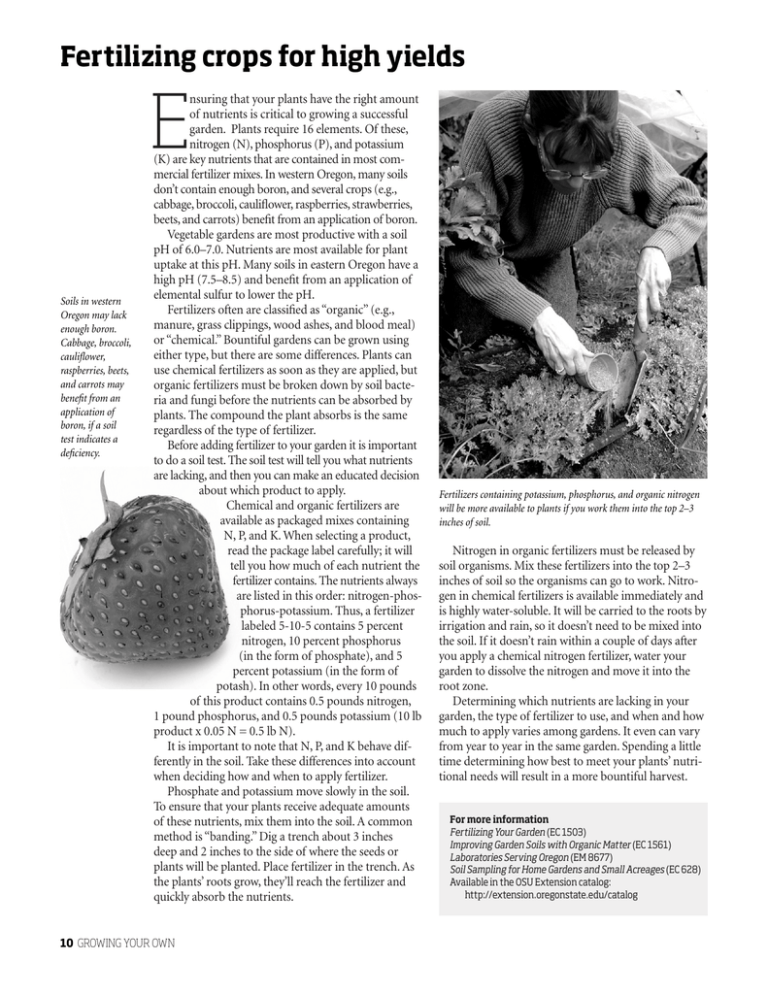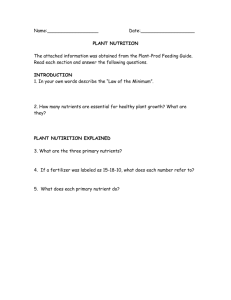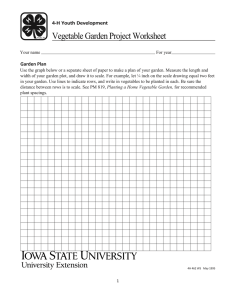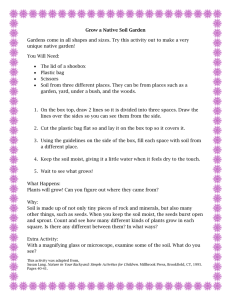E Fertilizing crops for high yields
advertisement

Fertilizing crops for high yields E Soils in western Oregon may lack enough boron. Cabbage, broccoli, cauliflower, raspberries, beets, and carrots may benefit from an application of boron, if a soil test indicates a deficiency. nsuring that your plants have the right amount of nutrients is critical to growing a successful garden. Plants require 16 elements. Of these, nitrogen (N), phosphorus (P), and potassium (K) are key nutrients that are contained in most commercial fertilizer mixes. In western Oregon, many soils don’t contain enough boron, and several crops (e.g., cabbage, broccoli, cauliflower, raspberries, strawberries, beets, and carrots) benefit from an application of boron. Vegetable gardens are most productive with a soil pH of 6.0–7.0. Nutrients are most available for plant uptake at this pH. Many soils in eastern Oregon have a high pH (7.5–8.5) and benefit from an application of elemental sulfur to lower the pH. Fertilizers often are classified as “organic” (e.g., manure, grass clippings, wood ashes, and blood meal) or “chemical.” Bountiful gardens can be grown using either type, but there are some differences. Plants can use chemical fertilizers as soon as they are applied, but organic fertilizers must be broken down by soil bacteria and fungi before the nutrients can be absorbed by plants. The compound the plant absorbs is the same regardless of the type of fertilizer. Before adding fertilizer to your garden it is important to do a soil test. The soil test will tell you what nutrients are lacking, and then you can make an educated decision about which product to apply. Chemical and organic fertilizers are available as packaged mixes containing N, P, and K. When selecting a product, read the package label carefully; it will tell you how much of each nutrient the fertilizer contains. The nutrients always are listed in this order: nitrogen-phosphorus-potassium. Thus, a fertilizer labeled 5-10-5 contains 5 percent nitrogen, 10 percent phosphorus (in the form of phosphate), and 5 percent potassium (in the form of potash). In other words, every 10 pounds of this product contains 0.5 pounds nitrogen, 1 pound phosphorus, and 0.5 pounds potassium (10 lb product x 0.05 N = 0.5 lb N). It is important to note that N, P, and K behave differently in the soil. Take these differences into account when deciding how and when to apply fertilizer. Phosphate and potassium move slowly in the soil. To ensure that your plants receive adequate amounts of these nutrients, mix them into the soil. A common method is “banding.” Dig a trench about 3 inches deep and 2 inches to the side of where the seeds or plants will be planted. Place fertilizer in the trench. As the plants’ roots grow, they’ll reach the fertilizer and quickly absorb the nutrients. 10 GROWING YOUR OWN Fertilizers containing potassium, phosphorus, and organic nitrogen will be more available to plants if you work them into the top 2–3 inches of soil. Nitrogen in organic fertilizers must be released by soil organisms. Mix these fertilizers into the top 2–3 inches of soil so the organisms can go to work. Nitrogen in chemical fertilizers is available immediately and is highly water-soluble. It will be carried to the roots by irrigation and rain, so it doesn’t need to be mixed into the soil. If it doesn’t rain within a couple of days after you apply a chemical nitrogen fertilizer, water your garden to dissolve the nitrogen and move it into the root zone. Determining which nutrients are lacking in your garden, the type of fertilizer to use, and when and how much to apply varies among gardens. It even can vary from year to year in the same garden. Spending a little time determining how best to meet your plants’ nutritional needs will result in a more bountiful harvest. For more information Fertilizing Your Garden (EC 1503) Improving Garden Soils with Organic Matter (EC 1561) Laboratories Serving Oregon (EM 8677) Soil Sampling for Home Gardens and Small Acreages (EC 628) Available in the OSU Extension catalog: http://extension.oregonstate.edu/catalog Vigor a key to disease-free garden G rowing healthy, vigorous plants is the key to producing quality fruits and vegetables. Plant diseases can kill garden plants, reduce yields, or cause unsightly blemishes on produce. By practicing a few basic gardening principles, you not only will improve the quality of your produce, but also will reduce the need for chemical sprays. Thinking about the needs of your plants is the first and most important factor to consider before planting your garden. Extension publications often will help you determine those needs. Plants vary in their requirements for sunlight, soil conditions, and irrigation. To keep plants healthy and productive, it is important that you understand and meet these needs. Choosing the right location for your garden is critical. Most vegetables prefer sunny locations with little or no shade. Consider moving your garden if it is located in partial shade, or prune overhanging tree branches to provide the needed sunshine. Generally speaking, the more sun, the better. Since plants convert sunshine to starches and sugars, plants grown in full sun will produce larger vegetables and sweeter fruit than those grown in partial shade. In addition, sunshine helps dry out wet foliage, thus reducing the potential for disease problems. Proper soil conditions are equally important to the health and vigor of plants. Most plants prefer a loam soil with good water drainage. Avoid low-lying areas where water collects, since damp conditions promote root rot. You can improve any soil by adding organic matter such as compost or peat moss. This is especially true of sandy and clay soils. Organic matter helps sandy soils hold water and nutrients. It provides clay soils with more air spaces so that roots can breathe more easily. Some plants, such as blueberries, prefer an acidic soil, but generally a pH of 6 to 7 is ideal for most plants. A soil test kit purchased from a garden center will help determine soil acidity. More detailed soil analyses to determine fertilizer requirements also are helpful. A list of soil testing laboratories is A soil test can help you determine how much fertilizer to add. Fertilizing too little or too much can make plants more susceptible to disease. available at your local Extension office. It is important that plants be adequately, yet not excessively, fertilized. Improper fertilization will make plants too weak or too vigorous and more subject to disease. There are several other factors to consider as you plan your garden. To prevent the buildup of disease organisms, rotate your crops from year to year on a four-year rotation. This also will prevent soils from becoming depleted of nutrients by plants that are heavy feeders. Consider the following rotation: root crop, followed by leaf or seed crop, then cabbage family crop, and finally legume. Legume crops, such as peas, help to restore the nitrogen supply in the soil. Select your seeds and plants carefully. In recent years, plant breeders have bred resistance to many diseases into seeds. Check seed catalogs and packages for resistance information. In addition, plant only disease-free transplants. Bargain plants that are unhealthy are no bargain since they may bring diseases to your garden and infect healthy plants. Once your garden is growing, thin plants to provide good air circulation. High humidity and wet leaves favor disease organisms such as mildew and Botrytis blight. In addition, overcrowded plants will be weak and starved for light, nutrients, and water, and will not yield an abundant harvest. Proper watering is critical to maintaining the health and vigor of plants. Scratch below the soil surface on a regular basis to check moisture content. Irrigate before the subsurface soil dries. To reduce the chance of leaf disease, water in the morning so that foliage has a chance to dry before nightfall. Control insect pests in and around your garden. Insects such as aphids and leafhoppers weaken plants and also can carry viruses from infected to noninfected plants. Destroy diseased plants or plant parts as soon as you see them so the disease will not spread. Avoid composting diseased plants; some diseases can live in compost. Weeds not only compete with desired plants for nutrients and water but serve as a reservoir for insects and diseases. It is best to destroy young weeds before they become established. Avoid using herbicides in and around vegetable gardens. Remove weeds with a hoe or by handpulling and prevent reestablishment by using a mulch. Choose diseaseresistant varieties to avoid many disease problems and grow healthier, more productive crops. For more information Fertilizing Your Garden (EC 1503) Laboratories Serving Oregon (EM 8677) Preventing Plant Disease in Your Garden and Landscape (FS 242) Soil Sampling for Home Gardens and Small Acreages (EC 628) Available in the OSU Extension catalog: http://extension.oregonstate.edu/catalog GROWING YOUR OWN 11





